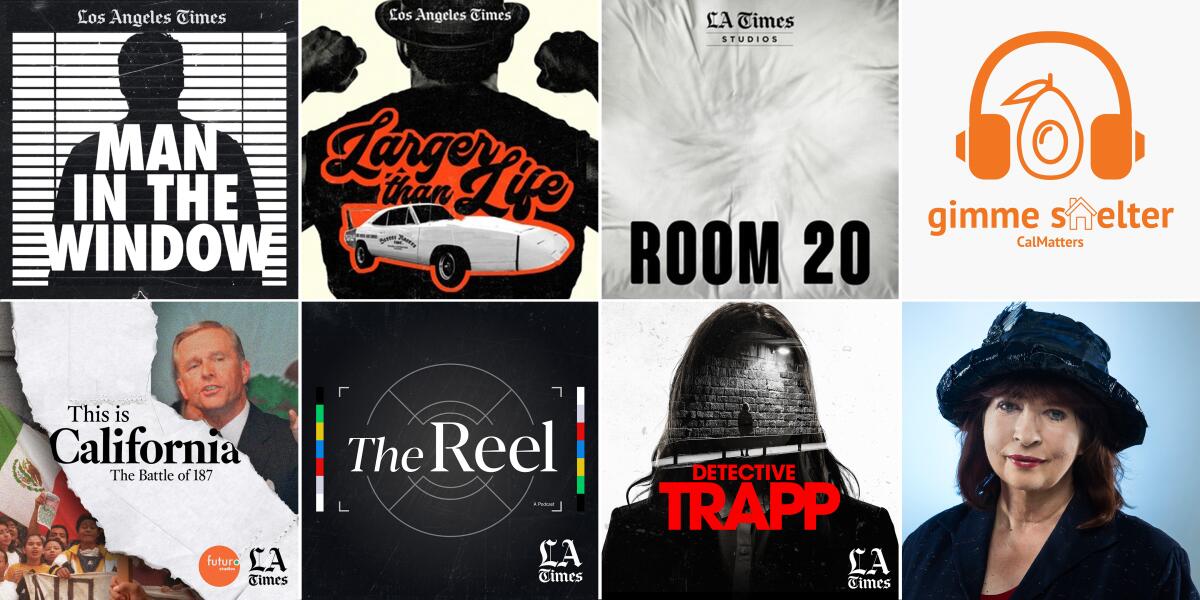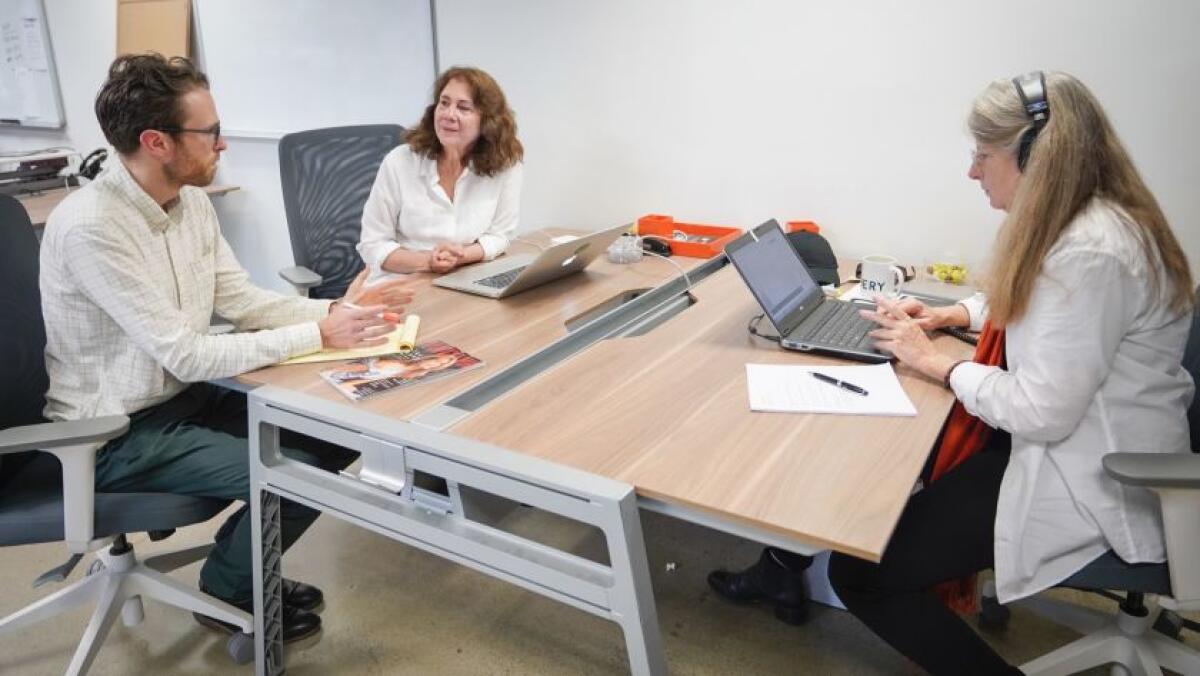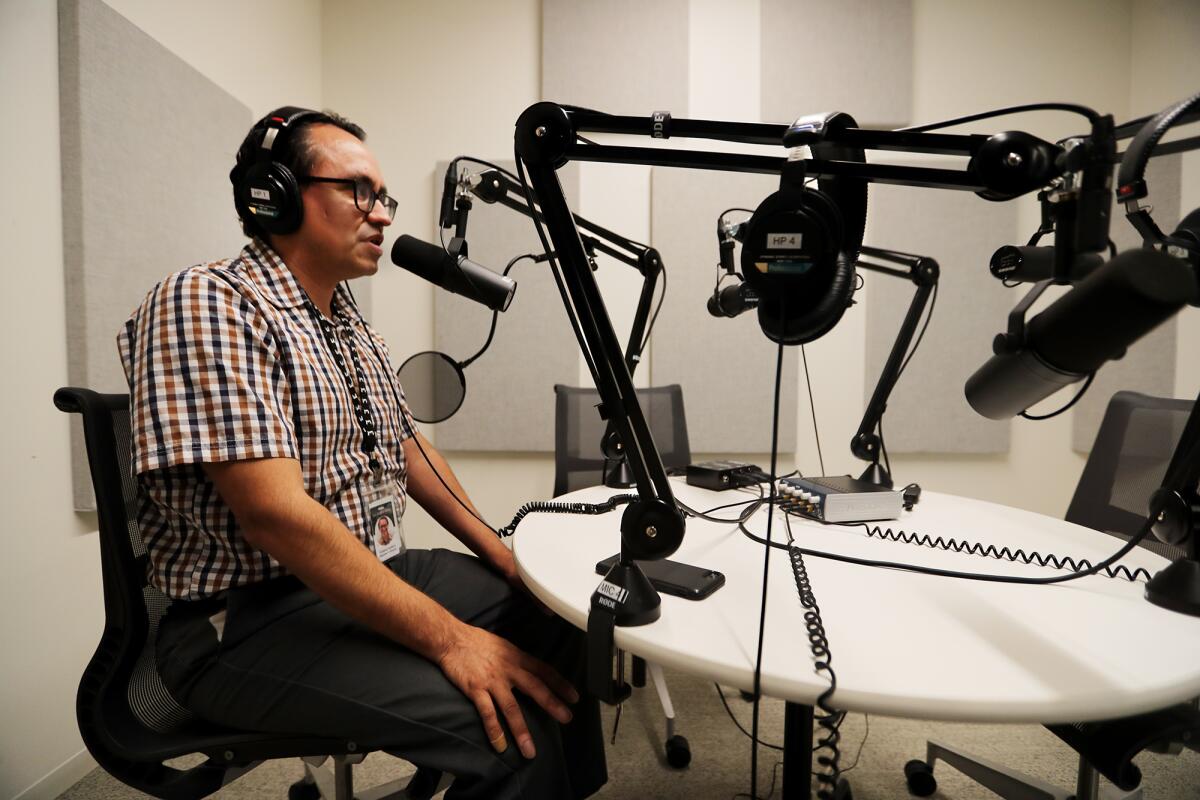The year in podcasts

- Share via
2019 has been an exceptionally busy podcast year for all of us here at the Los Angeles Times. Drawing on the successes of our previous podcasts, such as 2017’s “Dirty John,” we spent 2019 launching further into the podcast landscape. And — there’s something for everyone. With our brilliant roster of hosts and guests, we launched into a world surrounded by vigorous investigative journalism, true-crime detective tales, stories at the heart of the immigration debate and so much more. Our podcasts transform the thought-provoking coverage The Times is known for, into engaging, sound-rich stories that represent the rich diversity of voices in California. And millions of downloads later, here’s a look (or listen) back on the year:
Man In The Window

For decades, the Golden State Killer eluded police and terrorized California. When the suspect Joseph James DeAngelo Jr. was arrested last year, his reign of terror came to an end. But for Times staff writer Paige St. John, it was just the beginning. The Pulitzer Prize-winning investigative reporter launched a six-part narrative podcast that dissects decades of crime and police work during the hunt to capture and identify the suspect. St. John was part of the team of Times reporters who rolled out the story the instant DeAngelo was arrested. But, “Man In The Window” explores an untold side of the story.
“I was blown away by the era. The 1970s were hostile to victims of sexual violence. Rape was lightly treated, seldom discussed, and victims suffered in silence. That social climate is so vastly different from today’s beliefs that I felt people needed to hear it — be immersed in it — to understand what was going on. Sacramento has a huge public treasure in the city’s archive of old television news footage, without which this immersion would not have been possible,” St. John told me for a newsletter earlier this year.
In the podcast, St. John breaks down the trivializing of sexual violence during the 1970s and ‘80s that led police to overlook some of these rapes and attacks.
Larger Than Life

When Times staff writer Daniel Miller heard about Big Willie Robinson, a Vietnam veteran turned leader of the National and International Brotherhood of Street Racers, he became obsessed with finding out more. Miller set out to discover the untold story of Big Willie, a legendary street racer who emerged after the Watts riots and found an unexpected way to unite people in L.A. across race and class. Miller hosted a seven-part documentary podcast about the street racer that takes listeners on a wild ride through L.A. history. And while Big Willie was a large part of the tale, so were the cars.
“When we set out to make “Larger Than Life,” one thing we knew we wanted was authentic audio of cars. We didn’t want to use stock sounds of revving or racing, because we wanted to be as true to the story as possible. So, when an episode called for the roar of a 1969 Dodge Charger Daytona with a Hemi V-8, that meant we had to go find one,” Miller told me for a newsletter earlier this year.
Plus, Miller and other Times colleagues tried a new approach with this podcast to help build a community around the story. They started a Facebook group to share parts of the story, and open up a dialogue for members of the group to participate in the conversation.
Room 20
How did an unconscious man remain unidentified for more than 15 years? That’s the question investigative reporter Joanne Faryon set out to answer in her podcast “Room 20.” Her two-year journey was filled with twists and turns as she tracked down the truth. She eventually reveals the identity of the unknown man, but Faryon still wondered: Has he been conscious this entire time?
“I have a personal connection to the story that has to do with my mother. I had spent nearly a year reporting on people on life support, and there was something that made me not want to give up this story. I actually quit my job to go on this podcast journey. I also became a little obsessed with the idea that 66 Garage was lying in a bed all this time alone and disconnected from the world and the people he loved. I could think of nothing sadder,” Faryon told me earlier this year.
It all started for Faryon back in 2014 when she was working for a San Diego news site on an investigative series about people kept alive on life support in California nursing homes. That’s when she discovered a John Doe, lying unconscious and unidentified in a nursing home. It was the mystery, search for truth, and personal connection that drew Faryon deeper into the untold story.
The Battle of 187

Times reporter Gustavo Arellano grew up in Southern California. Despite being the son of an immigrant father from Mexico, his 15-year-old-self had no idea about the hate and anger toward people like his dad. But 25 years ago, in 1994, a ballot proposition surfaced that changed Arellano and the state of California forever. So, he set out to explore this controversial proposition in a three-part podcast called “This is California: The Battle of 187.”
Proposition 187 sought to drive away immigrants without documentation by denying them public healthcare, social services and education, among other publicly funded services. In 1994, the initiative easily passed, 59% to 41%, but it created a generation of Latinos whose influence on California can be felt from Hollywood to Sacramento, from universities to high school classrooms.
“It’s now a political parable told nationwide: What happens when you run a campaign that casts Latinos as invaders, as 187 did? Modern-day California, where Democrats hold a supermajority in both chambers of the California State Legislature, and use their powers to help out undocumented immigrants instead of demonize them,” Arellano told Times staff writer Julia Wick for a newsletter earlier this year.
The podcast traces the proposition from its birth in Orange County to its peak on election day and its ultimate failure in the courts.
The Reel

Here in L.A., of course we have a weekly podcast with smart, engaging conversations on the entertainment industry, fresh from the people who know it best. Hosted by Times film critic Mark Olsen, “The Reel” explores Hollywood’s hidden gems to blockbusters to the biggest moments in show business. Olsen takes you behind the scenes and on the front lines of the entertainment industry. You’ll hear from guests such as Steven Soderbergh, who sat down with Olsen live from the Slamdance Film Festival this year. Or listen to Taron Egerton, who plays Elton John in “Rocketman,” when he spoke with Olsen about what it was like to portray such a renowned musical icon. You’ll also hear from directors such as Kasi Lemmons, Melina Matsoukas, James Mangold and Spike Lee.
“What I have come to most enjoy about putting together an entertainment podcast is the immediacy of it, that we can really talk about what’s going on right now, in this moment. Hearing people talk feels unfiltered, giving the show a high-wire energy. Also, because we are all so busy, it can be pretty rare to sit down with my colleagues here at the LAT for in-depth conversations, so it has been so exciting to have those opportunities for longer talks,” said Olsen.
The podcast features retrospective episodes as well, including an episode focused on “Southland Tales” with filmmaker Richard Kelly and another about “Heathers” with director Michael Lehmann, writer Daniel Waters and actress Lisanne Falk. This year we also started a new culture news segment where Olsen sits down with reporters and critics from The Times’ celebrated film and television teams. A new episode of “The Reel” releases every Friday morning.
Patt Morrison Asks
Los Angeles Times writer Patt Morrison continues to host her weekly interview series that explores the intersection of arts, politics and culture grounded in California. Morrison, a Pulitzer Prize- winning writer, reveals fresh news and then takes you into a deeper, unexpected angle on the story. Through insightful interviews and unique anecdotes from guests, each episode of “Patt Morrison Asks” brings you closer to the conversation. This year, Morrison spoke with guests including former Google CEO Eric Schmidt about the state of technology today. She also talked to Salman Rushdie about his latest book.
“A real reporter is annoyingly curious, and a podcast lets me play the field with an infinite range of subjects, rummaging around in some very smart person’s brain to gratify my curiosity and, I hope, pique the listener’s. I always say that your ears are two of the most intimate orifices in your body. And telling a story — compared to writing it or videotaping it — is humanity’s original medium,” Morrison told me for a newsletter earlier this year.
In the past she’s interviewed guests such as Joan Baez, John Kerry and Neil deGrasse Tyson. Morrison suggests starting with the Baez episode where they discuss her farewell tour, the current state of protest music and how President Trump inspired Baez to write a new song. Or, check out the episode with women’s rights campaigner Bernice Sandler, who died this year. Sandler was the godmother of Title IX, and Morrison interviewed her a year or so before her death. You can catch a new episode of the show every Tuesday.
Gimme Shelter: The California Housing Crisis Pod
Why is it so expensive to live in California? That’s what the two hosts of the “Gimme Shelter” podcast continue to explore every other week on their show. It’s a partnership between Los Angeles Times housing reporter Liam Dillon and CalMatters data reporter Matt Levin. They chat about the latest developments in California housing policy and examine the underlying causes for why it’s so unaffordable to live in California.
Dillon suggests starting with one recent episode that looks at what could happen in specific neighborhoods if a boom in development were to occur there.
“We dug deep to understand how increases in homebuilding affect what people pay to live in a specific neighborhood and how new development might affect existing residents, particularly in communities that might be at risk of or already experiencing gentrification or displacement. It’s a nuanced look at what the effects on your rent will be when you see those big cranes in San Francisco, Los Angeles or anywhere else in California,” Dillon said. “If you listen to us, you’ll be informed and up to date about the latest problems due to the rising costs of housing in California and proposed solutions.”
Detective Trapp
The L.A. Times rounded out 2019 with a familiar voice: Christopher Goffard. After the success of his first podcast, “Dirty John,” he returns with another dive into true crime with “Detective Trapp.” This time, he tells the tale of an Anaheim investigator named Julissa Trapp. She’s the only woman on the homicide squad. A master interrogator, she invokes her personal experience — and deepest griefs — as a tool to elicit confessions. Goffard first met Trapp at the Orange County courthouse, where he discovered her tenacious police work and obsession with solving the case.
“I learned that Trapp had taken a big risk when she inherited the case in March 2014 with the discovery of 21-year-old Jarrae Estepp’s mangled body at a trash-sorting plant in Anaheim. She promised Estepp’s mother she’d find the killer. It’s the sort of promise detectives make in movies, but that their real-life counterparts are loath to do, because they know how many murders go unsolved, how a thousand unforeseeable things can relegate them to the permanent cold-case file,” Goffard wrote in a piece about what inspired his new podcast.
In “Detective Trapp,” Goffard begins by exploring Trapp’s cases involving a series of women who vanished from the streets of Orange County. At first, police were slow to move on the case and some assumed the women may have left town on their own. Trapp did not know if, or how, the cases were related. She didn’t know how large the investigation would become, or how it would consume her for years. In the end, after scores of other cops had moved on, solving the final mystery would be her job alone.
That’s it for this year’s podcast roundup from the Los Angeles Times. Here’s to 2020. Keep an ear out for what’s to come next.
More to Read
Sign up for Essential California
The most important California stories and recommendations in your inbox every morning.
You may occasionally receive promotional content from the Los Angeles Times.














